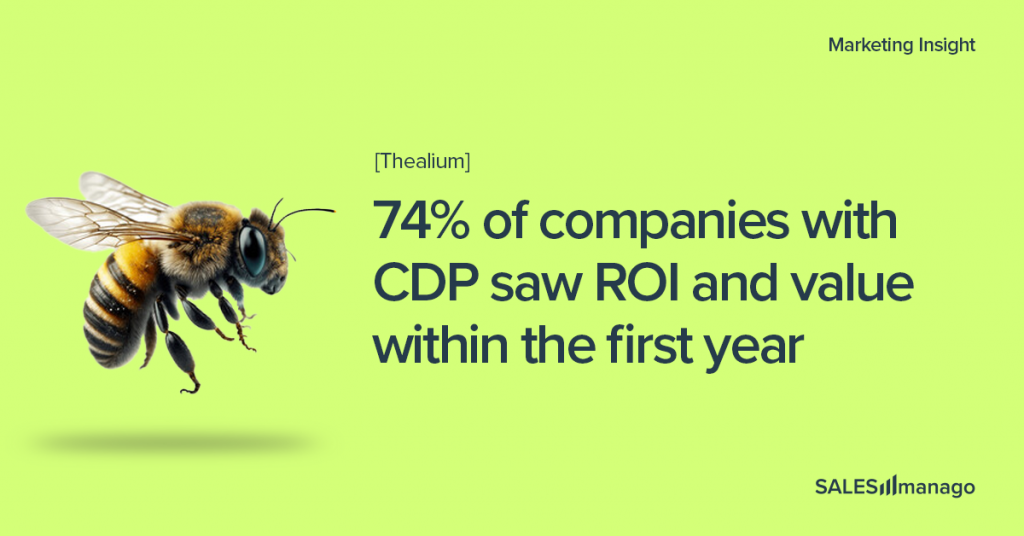
Are you familiar with the differences between a Customer Engagement Platform and a Customer Data Platform? While you might already know about Customer Data Platforms and may even use them, a Customer Engagement Platform has much more to offer than just collecting and consolidating data.
In fact, a Customer Engagement Platform can have a huge impact on your marketing team’s capabilities and empower them to achieve much more. That’s why we’re excited to dive deeper into this topic and explain the unique features and benefits of a Customer Engagement Platform in this article.
So, let’s get started and explore why a Customer Engagement Platform is more than just a Customer Data Platform, and how it can revolutionize the way you engage with your customers.
To face the challenges facing businesses today, marketers must rely heavily on technology that enables them to act lean and with tremendous precision and effectiveness. However, the martech landscape never stops producing new acronyms for next-gen products and systems. This only adds to the confusion. What is CEP? Is it just a new buzzword for CDP?
Modern marketers can easily find themselves constantly seeking the ideal martech stack setup and new tools—instead of focusing on customers and their experiences with your brand. You may assume that there is nothing new to the appearance of catchy new acronyms. This way of thinking is misleading. Martech is developing rapidly, and novel iterations of various systems exponentially empower those who keep a finger on the technology’s pulse.
In order to keep up, marketing teams are forced to learn new, more efficient and independent ways of conducting operations—Lean Ways. And Customer Engagement Platforms are tailored just for this.
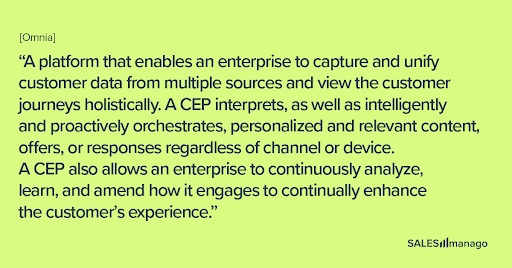
What is CDP? A Quick Reminder
This question was already answered in What Is A Customer Data Platform? CDP In A Nutshell part1. Here is just a quick summary.
According to CDP Institute, a Customer Data Platform is a “packaged software that creates a persistent, unified customer database that is accessible to other systems.”
“Packaged software” means that CDP is a ready-to-use, off-the-shelf software usually provided by the vendor.
“Persistent, unified customer database” means that CDP collects data from many different sources, i.e., all the company’s touchpoints, where it is possible to acquire first-party consumer data such as sales, loyalty, customer service, social media, etc. Such datasets are called first-party data. There is also zero-party data, i.e., information provided voluntarily by customers.
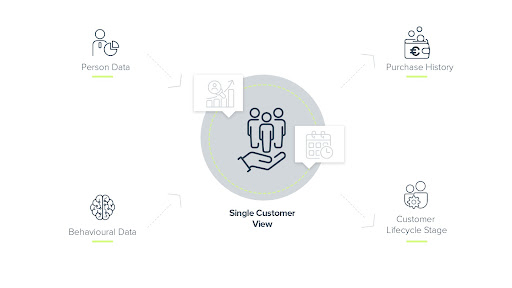
Data from different sources are stored in CDP, then merged and unified into a single customer profile.
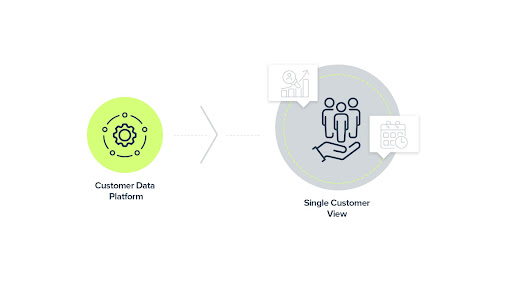
Finally, “accessible to other systems” means that customer data is shared with any other system that needs it, such as those used by sales, marketing, and commerce.
In other words, CDP, at its core, gathers data from multiple sources, cleans it, and constructs a unified customer profile, —a single source of truth, accessible to all of a company’s departments.
And that’s really all it takes to call a system a Customer Data Platform. But, currently, it is rare that a CDP company offers only this.
CDP can be merged with AI-driven, advanced analytic tools. Such a system is called CIP—Customer Intelligence Platform. We also explained this type of software in detail in What Is A Customer Data Platform? CDP In A Nutshell part1.
So, can this type of “evolved CDP” with some add-ons be called a Customer Engagement Platform?
No. It takes much more than this.
What Is a Real Customer Engagement Platform?
Many CDPs started as different types of software. Some stem from legacy CRM systems designed mainly for data management, but have evolved into platforms that are cloud-based, analytics-driven, and compatible with other apps.
Others have CDPs at their core. As we mentioned earlier, CDPs collect data from multiple sources in real-time, unify the data into customer profiles, and then send it to marketing, sales, customer support, and analytics tools.
Some modern CRMs and CDPs fulfill some CEP functions but activate data by sending it to downstream tools. A real Customer Engagement Platform activates data within the system itself.
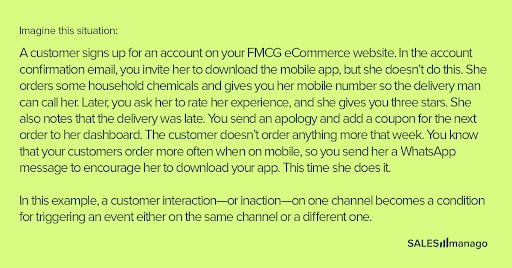
This is exactly how we’ve been developing the SALESmanago system for years. Our Customer Engagement Platform stems from CDP, and was later enriched with Marketing Automation. Since then, we have built our system as comprehensive software, able to activate data within itself.
All the system’s layers play a vital role in making marketing teams trusted revenue partners to their CEOs.
- The CDP layer gathers and orchestrates data from multiple sources.
- The Hyper-personalized execution layer actions data in an optimized, lean, and effective way.
- The marketing development layer enables the perfection of marketing processes with the support of both AI-based and human guidance.
Together, these layers enable marketing teams to:
- Get intimate knowledge about their customers and create a meaningful bond;
- Deliver the best offer in the optimal time via the best channel; and
- Constantly develop and refine the process, thereby strengthening customer engagement and increasing CLV as well as Average Order Value.
We formulated these effects as three principles:
- Customer Intimacy
- Precision Execution
- Growth Intelligence.
Customer Intimacy. CDP Layer
At the core of the SALESmanago system lies CDP, directly tied to the Customer Intimacy rule:
Implementing self-learning solutions that leverage zero- and first-party data to know your customers better than your friends. It results in increased loyalty and authentic customer relationships.
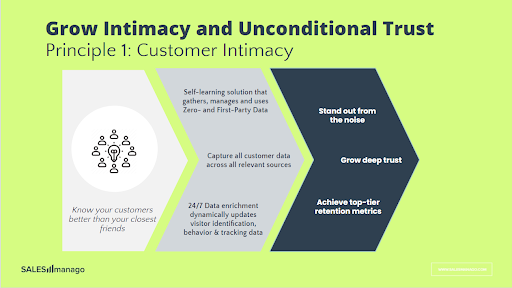
This layer is a self-sustaining ecosystem that gathers, manages, and makes data actionable in real-time across all execution channels. It feeds with:
- zero-party data shared intentionally by the customers;
- first-party data, namely transactional and behavioral data which customers allow you to gather automatically; and
- third party data, which is any data you might bring from external sources.
Customer data is gathered within a 360 Customer View equipped with the next generation of AI Predictions around Products, Churn, Lifetime, and delivery channels. SALESmanago stands out among CDPs, with a strong focus on zero-party data and next-generation tools for analyzing customer behavior on the website.
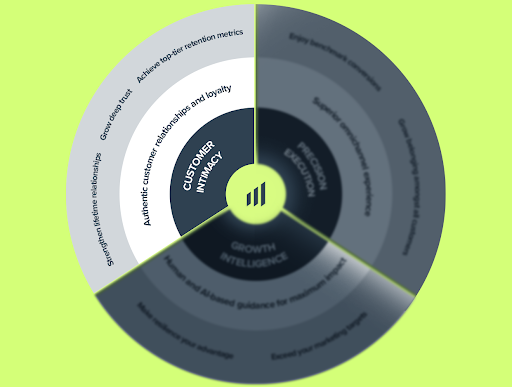
Precision Execution. Hyper-personalized Omnichannel Execution Layer
The second layer enables marketing teams to execute hyper-personalized omnichannel communication.It embodies the second rule, Precision Execution:
Combining hyper-personalization of the omnichannel experience with clearly predefined processes. It results in higher CR, AOV, and CLV as well as lower customer churn.
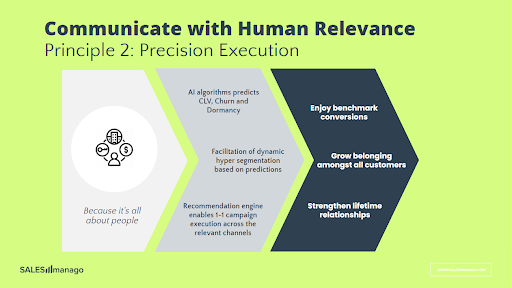
Precision Execution enables marketing teams to run campaigns and other processes on the basis of ready-made workflow templates, addressing the most important challenges and improving key e-commerce KPIs. For custom processes, SALESmanago provides a workflow engine with unlimited potential for building omnichannel processes without the need for IT department support.
As a real Customer Engagement Platform, SALESmanago’s CDP has been natively integrated with in-house built marketing tools. This makes activating customer data extremely easy. For example, you may have consistent product recommendations ready to deliver to your customer via any channel: email, Web Push, Social Media, or even Live Chat. SALESmanago lets you do this with just a few clicks.
Eventually, all these channels lead a customer to your website. At this moment, their expectations are very high because, until now, you’ve been extremely accurate with your hyper-personalized offer. To live up to these expectations, you can turn the ordinary website’s front into a hyper-personalized, high-conversion touch point. You can equip the site with personalized banners and AI-driven product recommendations to achieve the best possible product relevance adapted to the Customer Profile stored in our CDP. Further steps to increase conversion would be to deploy Social Proof and Live Chat.
Last but definitely not least, our Personal Shopping Inbox is the only widget on the market enabling you to run 1-to-1 communication, send special offers, or let customers create wish lists. Personal Shopping Inbox is also an invaluable source of zero-party data.
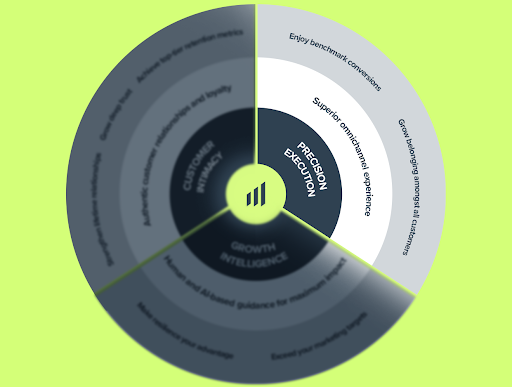
Growth Intelligence. Marketing Development Layer
The third and final layer embodies the rule we call Growth Intelligence:
Merging human and AI-based guidance to maximize the impact of your time, eCommerce budget, and strategy without dependency on IT. It enables full control of your revenue outcomes.
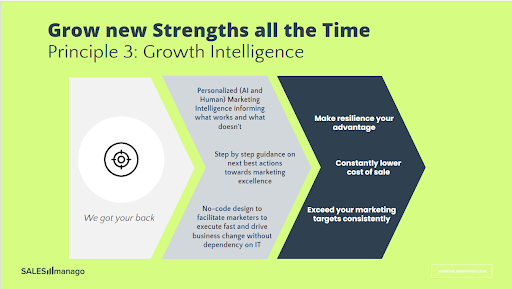
Growth intelligence is not only about smart advice for marketers. It’s the philosophy our platform has been built around, making marketers independent, time efficient, and fully empowered.
Our human and AI-based guidance will help you maximize the impact of your time, budget, and strategy without dependency on IT. You will get real-time advice on where to allocate your time and resources. Our AI will find groups of customers you should take care of and suggest what actions should be taken.
And you will not be alone in finding solutions. Within the platform itself, you will find a wide range of ready-to-use workflow templates addressing key marketing metrics.
The analytical part contains comprehensive information on how our platform is affecting revenue directly and indirectly, which channels perform well, and what the perfect omnichannel mix is for maximizing revenue.
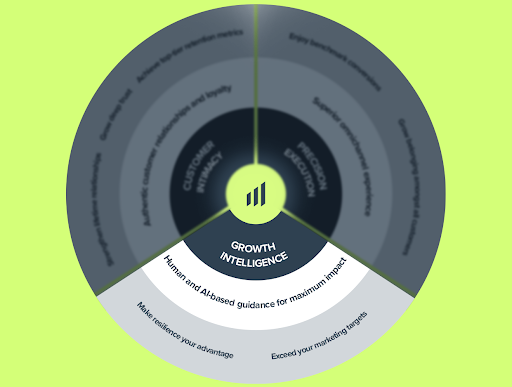
Customer Engagement Platform – the definition
Omnia’s comprehensive definition states that real CEP is “A platform that enables an enterprise to capture and unify customer data from multiple sources and view the customer journeys holistically. A CEP interprets, as well as intelligently and proactively orchestrates, personalized and relevant content, offers, or responses regardless of channel or device. A CEP also allows an enterprise to continuously analyze, learn, and amend how it engages to continually enhance the customer’s experience.”
According to this definition, 3 layers of the SALESmanago system make it a Customer Engagement Platform.
Wrapping Up
The difference between Customer Data Platform and Customer Engagement Platform is, in reality, as apparent as the difference between data and engagement.
With pure CDP you must elicit this engagement yourself, using a costly multitude of external tools deployed and orchestrated by the IT department, which itself is a very costly department. But first, you have to choose how to compose your martech stack, what type of functionalities to include, and which vendor you should choose for each functionality. Then you have to put in a lot of effort to make it work, and the company has to put in a lot of money to support you.
CEP activates data within the system of natively built tools, in the most advanced cases (like SALESmanago) without any dependency on IT. You don’t have to compose a martech stack by yourself and then maintain it to stay operational. The vendor takes care of this.
The final product of CDPis a Single Customer View or 360 Customer Profile, this is where its role ends The final CEPs product is customer engagement and all the benefits that come with it.
This guarantees that any marketing team can be powerful, pragmatic, and lean—and a trusted revenue partner to your CEO.
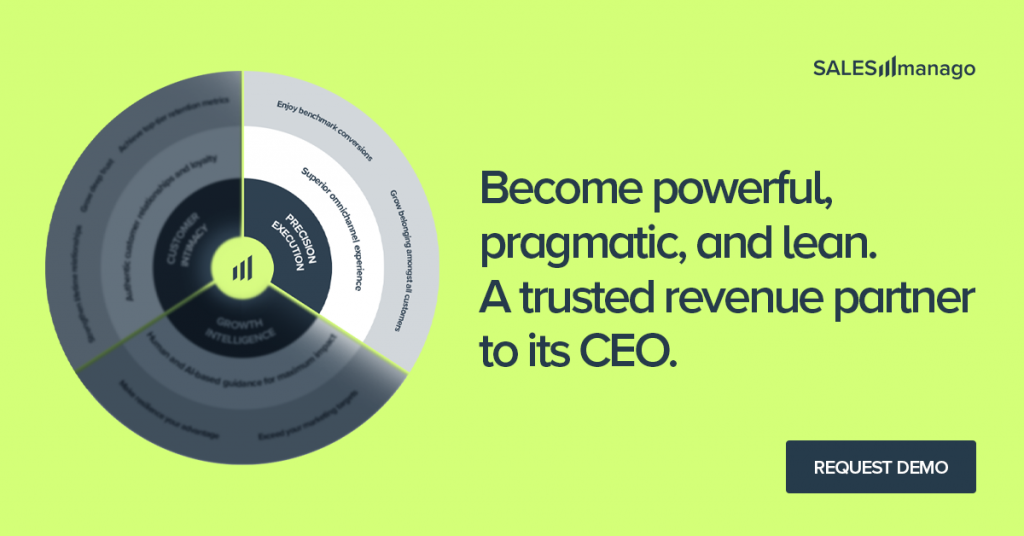
 Follow
Follow
















